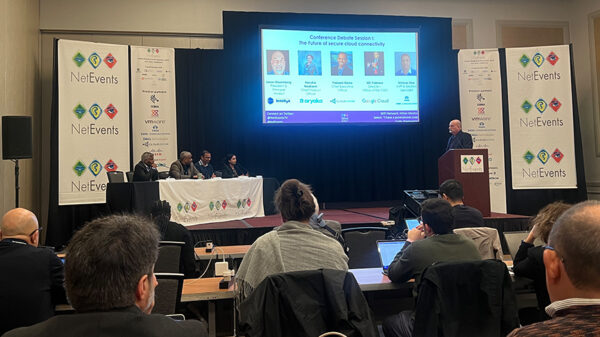 Infinera vice president – Asia Pacific Andrew Bond-Webster shares some of the tips on SDN (software defined networks) for telecom operators.
Infinera vice president – Asia Pacific Andrew Bond-Webster shares some of the tips on SDN (software defined networks) for telecom operators.
Carrier customers are demanding more flexible and future-proof networks that can scale rapidly and provide super-fast service provisioning times to eliminate the costly delays between the time a service is demanded and the time it is provisioned and producing revenue.
Tips to telecom CTOs on SDN
1. Make sure you solutions are future-proof and easily upgradeable
2. Make sure your solutions are SDN open-standards capable
3. For network management, you will need multi-layer solutions featuring automation to reduce opex
4. Use systems that are single-screen, seamless and simple to operate
5. Automate everything
SDN opportunities
In today’s competitive business landscape carriers are squeezed between ever-increasing bandwidth demand and consumers’ desire not to pay more for increased bandwidth services. As a result carriers are looking for automation and other integrated software solutions that can save them opex through agility and simplicity. The opportunity lies with the most innovative technology that is also the quickest and easiest to use and not with commodity competition based on price alone. Carriers who do not invest in the most superior technology solutions may ultimately pay the price with customer churn.
Capex plans of telecoms
With regard to internet content providers, it is difficult to ascertain how their networking Capex spend compares to tier 1s and tier 2s. However, they are definitely building big long haul and big metro networks. There does not seem to be any slowdown in the growth of internet traffic and service providers remain committed to building the capacity needed to grow their businesses. With regard to Capex we certainly see the spend increasing while the spend on legacy technologies is going to shrink. Overall, we do not see any fundamental slowdown in the capacity that our customers want to put in place in the short and medium term.
When combined with the multi-terabit OTN switching of the DTN-X platform, service providers now have a converged multi-layer solution with digital grooming of client services and optical switching of efficiently filled super-channels. Together these enable service providers to respond quickly to changing service and traffic demands while simplifying network operations.
For the first time, the same standards based multi-layer control plane controls the digital OTN switching for point and click service establishment as well as the switching of flexible grid super-channels at the optical layer. This combination uniquely enables service providers to automate everything in the Intelligent Transport Network.
Infinera’s customers in the Asia Pacific region include Telstra Global, FX Networks, Australia Japan Cable, PacNet, KVH, Pacific Northwest Gigapop, Pipe Networks, Dacom, NTT Communications, etc.
Customer benefits
Telstra Global
The Infinera Intelligent Transport Network will enable Telstra to quickly deploy 10G, 40G and 100G Ethernet and OTN services.
Darrin Webb, chief operating oOfficer for Telstra Global said, “As a trusted network supplier, our job is to ensure we are adapting and creating capacity where it is required. Demand for network services in the Asia Pacific region is growing exponentially and the addition of Infinera’s DTN-X platform means we will be well placed to meet the speed and capacity needs of our customers.”
FX Networks
The DTN-X, featuring 500 Gigabit per second (Gb/s) long haul super-channels enables FX Networks to build a new network infrastructure delivering 10, 40 and 100 Gigabit Ethernet (GbE) services to service providers and research and education networks.
David Heald, CEO at FX Networks, said: “The deployment of Infinera’s DTN-X platform is a crucial part of our strategy to provide uncontended, reliable, cost effective data services between New Zealand’s UFB Points of Interconnect, which are becoming the key locations for data aggregation in New Zealand.”
Australia Japan Cable
Infinera provides AJC with the DTN-X platform featuring long haul super-channels with SD-FEC based on the industry’s most widely deployed Photonic Integrated Circuit and the FlexCoherent Processor, supporting up to 500 Gigabit per second (Gb/s) in a single line card. The DTN-X platform is also equipped with 1 Tb/s per slot to support higher capacity 1 Tb/s super-channel line cards for future scaling needs.
Philip Murphy, head of Engineering at Australia Japan Cable, said: “To meet the growing bandwidth needs of carrier, enterprise and ISP customers, AJC is significantly increasing the capacity of our network.
Technology trends
Super-Channels — supporting multiple 100G/s channel services on one line card and/or one area of optical frequency to dramatically increase broadband capacity on the same fiber or chassis infrastructure, said Andrew Bond-Webster.
Beyond 100G into the Terabit era — though most operators are currently upgrading to 100G equipment and beginning to offer 100G services they also look to a future when terabit channels or services will be available to meet ever-growing bandwidth demand.
Multi-layer automation (layers 0-3) from the optical, digital and data link layers (0-2) down into the router layer (3) enabling networks to automatically re-route traffic for greater resiliency and throughput in the event of congestion, route disruption or simply to optimize traffic and avoid router hops that can cause delays by taking traffic out of the optical layer and sending it more slowly through several destinations on the Internet.
OpenFlow or open standards-based Carrier SDN—to abstract and unify layers 0-3 for single screen management. SDN can be used to automatically provision services and optimize network resources, such as dynamically increasing or rerouting data center to data center interconnect bandwidth services, across a multi-layer network as traffic demands change including multi-layer provisioning and multi-layer automation.
Multi-layer provisioning using SDN enables services and bandwidth to be dynamically provisioned via a single screen across the router layer and transport layer to speed service delivery and save operational costs.
Infinera recently collaborated with Telefonica for a successful demonstration of Network-as-a-Service (NaaS) in a multi-layer environment using the SDN approach. This collaboration highlighted the power of an open SDN approach and how it can unleash the innovation of a carrier like Telefónica.
SDN allows service providers to unleash their creativity and innovation to develop new multi-layer services rapidly and free from the constraints of proprietary operating systems and traditional element management systems.




















































































































